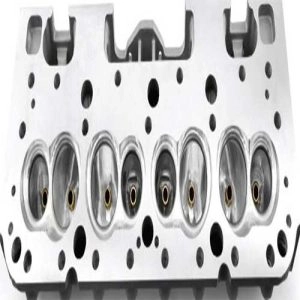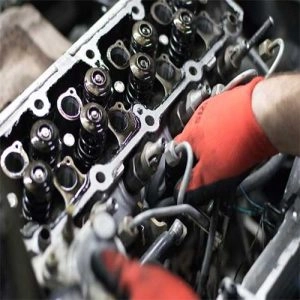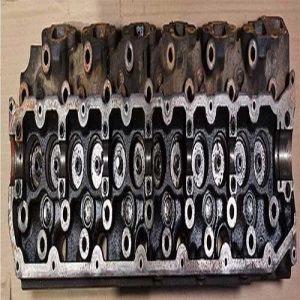The engine head, it's no secret that the car's engine is its indispensable core. It is the most essential and important part of the car. Therefore, there are many sensors and devices in the car that work to ensure the correct functioning of the engine and try to prevent any malfunction that may occur. It's worth mentioning that the car's engine consists of many parts, and perhaps the engine head is one of the most prominent and important of these parts.
The cylinder head, is the upper part of the engine that seals the combustion chambers and provides space for the passages that supply the cylinders with fuel and air. In addition, the cylinder head holds many different parts, such as the air and fire valves, injectors, spark plugs, camshafts, and valve tappets. The head also includes multiple paths for engine coolant and car oil.
However, it's important to know that the engine head itself can be damaged just like any other part of the car, and when this happens, it becomes a real problem for the vehicle. It's always better to avoid this issue, so let's discuss the main reasons that could lead to the damage of the engine head.
Reasons for Cylinder Head Damage:

Several factors can cause damage to the engine head, among the most important are air within the cooling system and high temperatures.
Temperature Increase:This is the most common cause and often leads to cylinder head damage. The temperature rises due to damage of the cylinder head's surface, a radiator coolant leak, or the restriction of the radiator coolant flow due to a faulty thermostat or water pump. This results in the cracking of the engine block head and could potentially lead to a complete engine failure in extreme cases, as the excessive heat and the engine's over-heating can cause cracks in its head, which is often made of aluminum.
Air inside the cooling system:In addition to the above, the air present within the cooling system can cause the engine temperature to rise depending on its quantity. This is due to the fact that air is not capable of transferring heat as well as the coolant does. Sometimes, the opposite can happen where the air accumulates in an area far from the temperature sensor - the sensor will then not pick up signals indicating a rise in temperature, which can lead to significant damage to the engine head.
In general, maintaining regular maintenance of the cooling system and engine can help reduce the risk of cylinder head damage and extend the life of the engine.
Also read:5 Signs Indicate Gasoline Sensor Damage
What are the signs of damage to the engine head?

Damage to the engine head can lead to many problems in the car, so it is essential to know some of the signs that indicate this damage. These signs include:
Engine oil deficiency:Checking your car's dipstick can reveal a decrease in oil level and quantity even though the car is running without problems. This could indicate an oil leak from one of the engine parts. If the leak is significant and noticeable, a warning light will appear on your dashboard, or you might see a large amount of oil seeping underneath your car. Cylinder head damage could be responsible for this slow engine oil leak.
Engine Performance Weakness:If the engine head contains several cracks, this leads to the leakage of compressed air from the combustion chamber in the engine. Consequently, the pressure resulting from the combustion process decreases, which results in a decline in engine performance, inability to accelerate normally, car stuttering, and higher fuel consumption.
Radiator Water Shortage:Also, one of the things that can leak from the engine head due to cracking is radiator fluid, which subsequently decreases continuously in the car. This leads to an increase in the engine temperature in case of external leakage. Sometimes, there might be internal leakage into the car, such as radiator fluid entering the combustion chamber or oil pathways. Therefore, it's essential to regularly check the level and quantity of the radiator fluid in the car, and one must not continue driving if a significant decrease and leakage in the radiator fluid level is found.
Engine Smoke OutputThis is the last possibility that can happen, and it's seldom noticeable, but large cracks in the engine head can sometimes cause the coolant to leak into the combustion chamber in the engine, resulting in white smoke coming out of the engine. Similarly, oil leakage and its contact with high-temperature parts of the engine leads to the same thing.
An Easy Method to Inspect the Engine Head

Through an easy method, you can inspect the head to check if it has been damaged or not, and this is done through the following steps:
Turn off the car and wait for it to cool down, then start the engine again and wait for about two minutes so that the engine stays cool.
2- Open the car's radiator cap, then place your hands well over the radiator opening so that air doesn't get in or out. Make sure that the engine is still cold while doing this to avoid the radiator water from being hot and thus hurting your hands.
3- Have another person press your car's gas pedal 6 consecutive times, while you keep pressing on the radiator cap and keeping it closed.
4- Ask the other person to stop pressing the gas pedal, but without turning off the engine, then lift your hands off the radiator opening. If you find that water is gushing from the radiator to the outside, this means that the engine head is damaged or there is a malfunction. However, if the water does not come out after you've lifted your hands, this is an indication that it's in good condition.Cylinder HeadAnd its safety, and that it does not need maintenance.

Comments